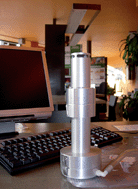Airborne particulate matter and BTEX in office environments
Abstract
Total suspended particulate (TSP), PM2.5 and BTEX were collected in nine offices in the province of Antwerp, Belgium. Both indoor and outdoor aerosol samples were analysed for their weight, elemental composition, and water-soluble fraction. Indoor TSP and PM2.5 concentrations ranged from 7–31 μg m−3 and 5–28 μg m−3, with an average of 18 and 11 μg m−3, respectively. Of all the elements analysed in indoor TSP, more than 95% was represented by Al, Si, K, Ca, Fe, Cl and S, accounting for 12% of the TSP by mass. The other elements showed significant enrichment relative to the earth's crust. The water-soluble ionic fraction accounted for almost 30% of the sampled indoor TSP by weight, and was enriched by anthropogenic activities. It was shown that the indoor PM levels varied among the offices, depending on the ventilation pattern, location, and occupation density of the office. Indoor BTEX levels ranged together from 5–47 μg m−3 and were considerably higher than the corresponding outdoor levels. It was observed that some recently constructed and renovated buildings were clearly burdened with elevated levels for


 Please wait while we load your content...
Please wait while we load your content...